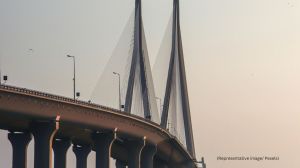Now, a cap over Chernobyl
Engineers are completing plans for what may be the largest movable structure ever built: a 20,000-ton steel shell to enclose Chernobyl React...

Engineers are completing plans for what may be the largest movable structure ever built: a 20,000-ton steel shell to enclose Chernobyl Reactor 4, site of an apocalyptic nuclear accident whose consequences are still being felt more than 16 years later.
By next summer an international consortium led by Bechtel International Systems Corp., of San Francisco, will finish the conceptual design for a hangar-shaped arch nearly 370 feet high that would be slid into place along greased steel plates to cover the ruined remains in a snug, weather-tight shelter.
Inside, robotic cranes and, where possible, live workers will then begin prying apart the wreckage, removing radioactive dust from twisted girders, storing pieces of radioactive core in shielded canisters and cutting old steel into manageable lengths. The whole job — design, construction and ‘‘stabilisation’’ of the derelict reactor — is part of a fully funded 10-year plan set in motion in 1997 by the Group of 7 industrialised nations.
The $768 million project, including the shell, is scheduled for completion in 2007. The shelter is designed to keep out water and dust in for 100 years, or for as long as it takes the Ukrainian government to designate a permanent storage facility and dispose of more than 200 tons of uranium and nearly a ton of lethally radioactive plutonium that remain inside the ruins.
Most of the fuel-containing material lies as a solid ‘‘lava’’ formed by the fusion of molten fuel, concrete, 30 tons of fuel dust, and 2,000 tons of combustibles. In the basement, rainwater and fuel dust have mixed together in a dangerous radioactive ‘‘soup.’’ Lethal chunks of the reactor core lie unseen in the rubble. More pieces of core were boxed and buried in a ‘‘cascade wall’’ built and bulldozed into place by Soviet workers in the immediate aftermath of the explosion.
Doubts arose as to whether a steel structure could last a century. With lethal levels of radiation inside the shell, opportunities for repair and maintenance could be limited. ‘‘It’s doable,’’ said Bechtel’s Matthew Wrona, project manager.
The team settled on a steel arch 40 feet thick. The inside dimensions would be 803 feet — almost three football fields — across and 330 feet high. Building the arch in place was impossible. Instead, the team decided to construct the arch in four 120-foot sections. (LATWP)
Photos



- 01
- 02
- 03
- 04
- 05




























